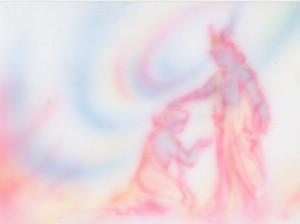
The boy with the flute is Sri Krishna. The Lord descended into the world-play from the divine Ananda; his flute is the music of the call which seeks to transform the lower ignorant play of mortal life and bring into it and establish in its place the Lila of his divine Ananda.
The outward action of the Avatar is described in the Gita as the restoration of the Dharma; when from age to age the Dharma fades, languishes, loses force and its opposite arises, strong and oppressive, then the Avatar comes and raises it again to power; and as these things in idea are always represented by things in action and by human beings who obey their impulsion, his mission is, in its most human and outward terms, to relieve the seekers of the Dharma who are oppressed by the reign of the reactionary darkness and to destroy the wrong-doers who seek to maintain the denial of the Dharma. But the language used can easily be given a poor and insufficient connotation which would deprive Avatarhood of all its spiritual depth of meaning.
Dharma is a word which has an ethical and practical, a natural and philosophical and a religious and spiritual significance, and it may be used in any of these senses exclusive of the others, in a purely ethical, a purely philosophical or a purely religious sense. Ethically it means the law of righteousness, the moral rule of conduct, or in a still more outward and practical significance social and political justice, or even simply the observation of the social law. If used in this sense we shall have to understand that when unrighteousness, injustice and oppression prevail, the Avatar descends to deliver the good and destroy the wicked, to break down injustice and oppression and restore the ethical balance of mankind.
Thus the popular and mythical account of the Krishna avatar is that the unrighteousness of the Kurus as incarnated in Duryodhana and his brothers became so great a burden to the earth that she had to call upon God to descend and lighten her load; accordingly Vishnu incarnated as Krishna, delivered the oppressed Pandavas and destroyed the unjust Kauravas.
We must then, in order to understand the Gita’s description of the work of the Avatar, take the idea of the Dharma in its fullest, deepest and largest conception, as the inner and the outer law by which the divine Will and Wisdom work out the spiritual evolution of mankind and its circumstances and results in the life of the race. Dharma in the Indian conception is not merely the good, the right, morality and justice, ethics; it is the whole government of all the relations of man with other beings, with Nature, with God, considered from the point of view of a divine principle working itself out in forms and laws of action, forms of the inner and the outer life, orderings of relations of every kind in the world. Dharma is both that which we hold to and that which holds together our inner and outer activities. In its primary sense it means a fundamental law of our nature which secretly conditions all our activities, and in this sense each being, type, species, individual, group has its own dharma. Secondly, there is the divine nature which has to develop and manifest in us, and in this sense dharma is the law of the inner workings by which that grows in our being. Thirdly, there is the law by which we govern our outgoing thought and action and our relations with each other so as to help best both our own growth and that of the human race towards the divine ideal.
– Sri Aurobindo





